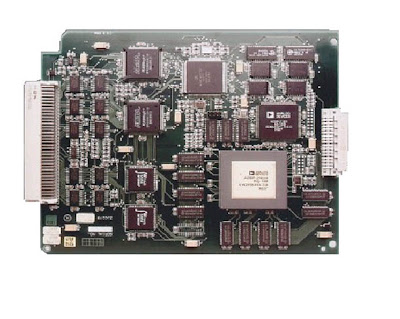1. S TAT IC RE L AY S
The term ‘static’ implies that the relay has no moving parts. This is not strictly the case for a static relay, as the output contacts are still generally attracted armature relays. In a protection relay, the term ‘static’ refers to the absence of moving parts to create the relay characteristic.
Introduction of static relays began in the early 1960’s. Their design is based on the use of analogue electronic devices instead of coils and magnets to create the relay
characteristic. Early versions used discrete devices such as transistors and diodes in conjunction with resistors, capacitors, inductors, etc., but advances in electronics enabled the use of linear and digital integrated circuits in later versions for signal processing and implementation of logic functions. While basic circuits may be common to a number of relays, the packaging was still essentially restricted to a single protection function per case, while complex functions required several cases of hardware suitably interconnected. User programming was restricted to the basic functions of adjustment of relay characteristic curves. They therefore can be viewed in simple terms as an analogue electronic replacement for electromechanical relays, with some additional flexibility in settings and some saving in space requirements. In some cases, relay burden is reduced,
making for reduced CT/VT output requirements.
A number of design problems had to be solved with static relays. In particular, the relays generally require a reliable source of d.c. power and measures to prevent damage to vulnerable electronic circuits had to be devised. Substation environments are particularly hostile to electronic circuits due to electrical interference of various forms that are commonly found (e.g. switching operations and the effect of faults). While it is possible to arrange for the d.c. supply to be generated from the measured quantities of the relay, this has the disadvantage of increasing the burden on the CT’s or VT’s, and there will be a minimum primary current or voltage below which the relay will not operate. This directly affects the possible sensitivity of the relay. So provision of an independent, highly reliable and secure source of relay power supply was an important consideration. To prevent maloperation or destruction of electronic devices during faults or switching operations, sensitive circuitry is housed in a shielded case to exclude common mode
and radiated interference. The devices may also be sensitive to static charge, requiring special precautions during handling, as damage from this cause may not be immediately apparent, but become apparent later in the form of premature failure of the relay. Therefore, radically different relay manufacturing facilities are required compared to electromechanical relays. Calibration and repair is no longer a task performed in the field without specialised equipment.
 |
| Selection of static relays |
2. D I G I TA L R E L AY S
Digital protection relays introduced a step change intechnology.Microprocessors and microcontrollers replaced analogue circuits used in static relays toimplement relay functions. Early examples began to be introduced into service around 1980, and, withimprovements in processing capacity, can still be regarded as current technology for many relay applications.However, such technology will be completely superseded within the next five years by numerical relays.
 |
| digital relay |
The microprocessor may use some kind of counting technique, or use the Discrete Fourier Transform (DFT) to implement the algorithm.However, the typical
microprocessors used have limited processing capacity and memory compared to that provided in numerical relays. The functionality tends therefore to be limited
and restricted largely to the protection function itself. Additional functionality compared to that provided by an electromechanical or static relay is usually available,
typically taking the form of a wider range of settings, and greater accuracy. A communications link to a remote computer may also be provided. The limited power of the microprocessors used in digital relays restricts the number of samples of the waveform that can be measured per cycle. This, in turn, limits the speed of operation of the relay in certain applications. Therefore, a digital relay for a particular protection

0 comments:
Post a Comment